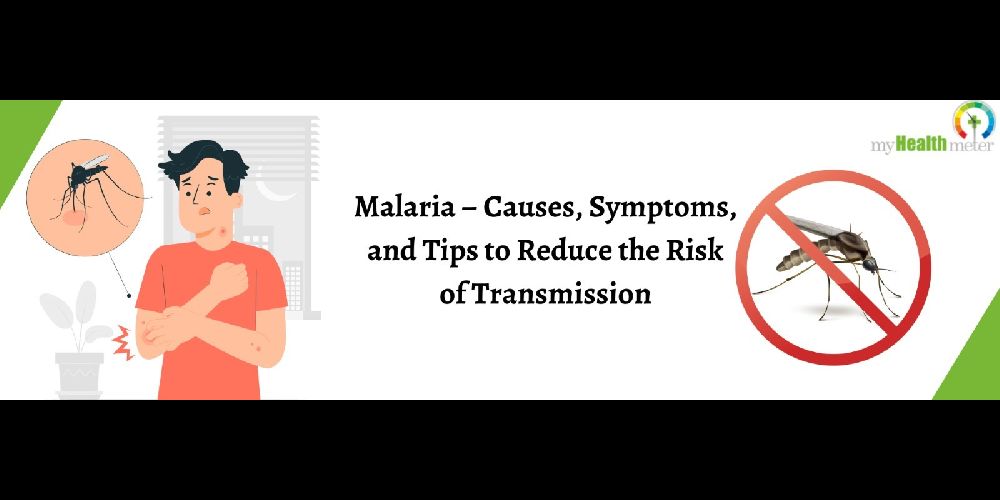Malaria – Causes, Symptoms, and Tips to Reduce the Risk of Transmission
-
April 24, 2023
-
814 Views
Malaria – Causes, Symptoms, and Tips to Reduce the Risk of Transmission
Malaria is a life-threatening infectious disease caused by the Plasmodium parasite. It is one of the most common and deadliest diseases in the world, especially in tropical and subtropical regions. Malaria is transmitted through the bites of infected Anopheles mosquitoes. Once the parasite enters the bloodstream, it multiplies rapidly, causing symptoms that can range from mild to severe.
There are five species of Plasmodium parasites that can cause malaria in humans: Plasmodium falciparum, Plasmodium vivax, Plasmodium malariae, Plasmodium ovale, and Plasmodium knowlesi. Of these, Plasmodium falciparum is the most dangerous and can cause severe malaria, leading to death if left untreated.
The life cycle of the Plasmodium parasite starts when an infected Anopheles mosquito bites a person and injects the parasite into their bloodstream. The parasite then multiplies rapidly in the liver before entering the bloodstream, where it infects and destroys red blood cells, leading to anemia and other complications.
Here are some of the causes of malaria:
- Mosquito bites: Malaria is primarily transmitted through the bites of infected Anopheles mosquitoes. These mosquitoes usually bite between dusk and dawn and are commonly found in tropical and subtropical regions of the world. When an infected mosquito bites a person, it injects the malaria parasite into their bloodstream.
- Contaminated blood: The malaria parasite can also be transmitted through blood transfusions, organ transplants, or the sharing of needles or syringes contaminated with infected blood. This is more common in areas with high rates of malaria transmission.
- Travelling to high-risk areas: People who live in or travel to areas with a high risk of malaria are more likely to get infected. This includes regions of Africa, Asia, and South America where malaria is endemic.
- Poor sanitation: Poor sanitation, lack of access to clean water, and inadequate health care facilities increase the risk of malaria transmission. This is because these factors can lead to stagnant water, which is a breeding ground for mosquitoes.
- Climate change: Climate change is also a factor in the spread of malaria. Warmer temperatures and changing weather patterns can create favorable conditions for mosquito breeding, increasing the risk of malaria transmission.
- Weakened immune systems: Children under the age of five, pregnant women, and people with weakened immune systems are at a higher risk of severe malaria. Individuals who have sickle cell disease, HIV/AIDS, or other conditions that affect the immune system are also more susceptible to malaria.
Symptoms of Malaria
- Fever: The most common symptom of malaria is fever. This is usually accompanied by chills and sweating. The fever can come and go, depending on the type of malaria.
- Headache: Headaches are also a common symptom of malaria. They can range from mild to severe and can be accompanied by other symptoms such as nausea and vomiting.
- Muscle pain: Malaria can cause muscle pain, especially in the back, arms, and legs. This can make it difficult to move around and perform everyday tasks.
- Fatigue: Fatigue is another common symptom of malaria. This can be due to the body's immune response to the infection, as well as the fever and other symptoms.
- Anaemia: Malaria can cause anaemia, which is a condition where the body does not have enough red blood cells. This can cause fatigue, weakness, and shortness of breath.
- Jaundice: In severe cases of malaria, the parasite can infect the liver and cause jaundice, which is a yellowing of the skin and eyes.
- Seizures: Malaria can cause seizures in some people, especially children. This is a serious symptom that requires immediate medical attention.
- Coma: In rare cases, malaria can cause a person to go into a coma. This is usually associated with severe malaria and requires urgent medical treatment.
Malaria is a major public health problem in India, with over 5 million cases reported every year. However, there are several preventive measures that individuals and communities can take to reduce the risk of malaria transmission. Here are some tips for preventing malaria in India:
- Use mosquito nets: Mosquito nets can be an effective way to prevent malaria, especially for people living in high-risk areas. According to the National Vector Borne Disease Control Programme (NVBDCP), the use of long-lasting insecticidal nets (LLINs) has led to a significant reduction in malaria cases in India. In 2018, over 110 million LLINs were distributed in India, covering approximately 40% of the population.
- Use insect repellents: Insect repellents can also be effective in preventing mosquito bites. Products containing DEET, picaridin, or lemon eucalyptus oil are recommended by the World Health Organization (WHO) for preventing malaria.
- Eliminate mosquito breeding sites: Mosquitoes breed in stagnant water, so it is important to eliminate or treat any sources of standing water around homes and communities. This includes removing old tires, emptying water from flower pots, and keeping gutters and drains clear.
- Wear protective clothing: Wearing long-sleeved shirts, pants, and socks can help prevent mosquito bites, especially during peak biting hours between dusk and dawn.
- Seek prompt medical attention: If you experience symptoms of malaria, such as fever, headaches, and muscle pain, seek medical attention immediately. Early diagnosis and treatment can prevent complications and save lives.
- Community awareness and education: Community awareness and education programs can be effective in preventing malaria transmission. These programs can include information about the causes of malaria, preventive measures, and the importance of seeking prompt medical attention.
Malaria is a life-threatening disease that can have serious consequences if left untreated. It is essential to be aware of the symptoms, causes, and preventive measures to avoid getting infected with malaria. By taking the necessary precautions and following the preventive tips mentioned above, we can all help to reduce the risk of malaria and create a safer and healthier environment.





